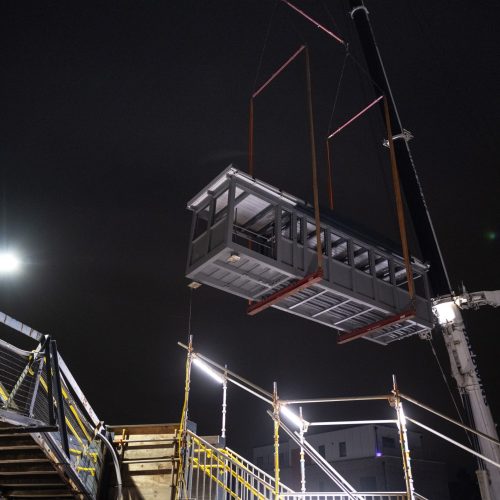Another new Access for All (AfA) upgraded station opens. But before the ceremonies, ribbon-cutting and public appreciation, there’s a story. It’s one of consultation, attention to detail and applied expertise.
While the overall aim of making rail travel easier for all is a constant, the precise means of getting to a successful outcome is always different.
Standards and guidance provide the bedrock for every project; so we never start with a completely blank sheet of paper. Onto those essential standards – we have to project the practical constraints of the location and layout of the existing station, the specific needs of station users and the local community, and the nuts and bolts of buildability.
Our teams also have to factor-in cost-effectiveness and minimising disruption, while all the time ensuring exemplary standards of safety for project teams and the general public. There are many components in successful delivery.
Collaboration is Critical
No individual or organisation has all of the knowledge and experience needed to meet all of these requirements and deliver a successful scheme. So the sooner you engage the right range of experts, the better.
To take one example: AfA schemes must consider the route from disabled parking bays to the station entrance, ensuring that it’s as short as possible, well marked, step-free and segregated from traffic.
That’s easy(ish) when those bays can be positioned right next to the station entrance – but often it’s more challenging in practice for urban stations. The car park used by travellers isn’t always adjacent to the station or even part of the estate. Solutions have to be collaborative.
Designing the Optimum Layout
The story continues inside the station. Finding the optimum layout that allows easy and obstacle-free access to ticket offices, toilets, cafes and waiting rooms may have to go through several iterations.
Most AfA schemes include ramps, lifts and footbridges. While standardisation is desirable to save time and cost, it’s not always entirely possible. To ensure the structural steelwork used in most AfA schemes can be installed quickly, seamlessly, and without major closures, detailed planning is essential – and that level of precision can only come from an experienced contractor being involved early in the process.
Where there’s a need for possessions – to install a modular footbridge for example – these have to be identified, approved and scheduled well ahead of time. They have to be as short as possible.
Island Platforms
Island platforms are a feature in many stations due for AfA upgrades. These inevitably bring access issues that make it impossible to undertake multiple activities simultaneously. Intelligent phasing is critical. These constraints can also lead to significant temporary works that have to be incorporated into the plan and constructed on a confined, live platform.
Project plans must be robust and detailed enough to be deliverable, yet with the flexibility to cope with the unexpected. And always supported by clear communications, information sharing and empowered decision-making.
Buried Services
The ‘unexpected’ might include buried services that aren’t fully mapped. At Barnes Station the plan had to accommodate diverting 20 signalling and telecom cables and a fibre optics cable carrying data for financial institutions and government departments.
The buried services were more extensive and important than originally believed. The diversions were completed successfully, with minimal impact upon the schedule and no impact on those relying on the cabling for uninterrupted data traffic.
Handover
With all the work scheduled and completed there’s still the vital handover process, which includes detailed digital plans and records, the user guide, and all relevant test and commissioning data.
There are many steps leading to the successful opening of an upgraded station. After over 35 successful projects – it’s a process and story we know well.
Access our AfA resource area below to find out more.
Access Our Resource Centre
By signing up, you’ll gain access to our resource hub, designed to support rail operators, designers and project teams in delivering successful Access for All (AfA) projects.
Access valuable resources, including:
- Proven Practices: Practical guides on AfA project management to improve efficiency, reduce costs and achieve sustainable outcomes.
- Regulatory Guidance: Clear insights into compliance requirements to ensure your projects meet the highest standards of accessibility and safety.
- InnovateUK Report Summary: Detailed findings on the future of accessible and inclusive rail travel in the UK.
- House of Commons Report Overview: An overview of the legislative framework for AfA, including its alignment with the Equality Act 2010.
Sign up today to access these essential resources—completely free.

